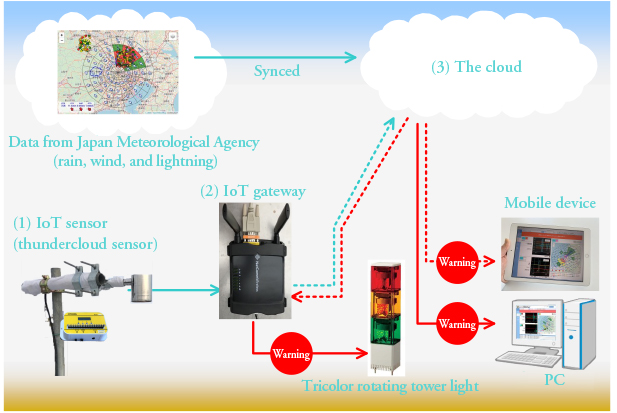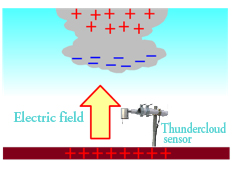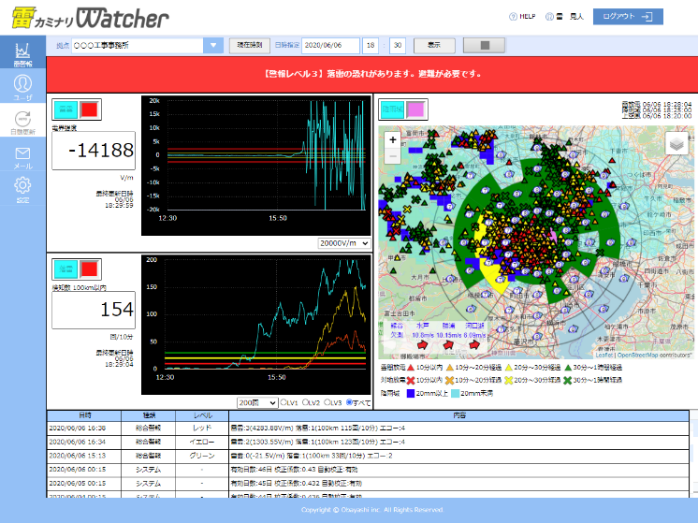- 4 Technology
- Technology Development
Kaminari Watcher Lightning Warning System
Obayashi Has Developed and Uses Kaminari Watcher Lightning Warning System
Detects approaching lightning and unforeseen lightning strikes ahead of time and increases safety at construction sites
Workers at construction sites must take a protective action immediately if there is a high risk of lightning strikes. It is especially dangerous if a crane is in use. Lightning could strike the top of the crane, travel through the lifting hook, and hit the ground.
There needs to be a system that can warn or alert workers of the risk of lightning strikes ahead of time. The existing system determines the probability of lightnings from approaching thunderclouds, using data collected from sensors that monitor lightning strikes in surrounding areas. However, thunderclouds do not always approach gradually. They can form near a worksite, and lightning could strike without any warning signs. Therefore, high-precision data is needed that is more specific to the location of the worksite.
That is why Obayashi Corporation developed Kaminari Watcher in 2013. This lightning warning system detects lighting that is approaching as well as sudden lightning strikes, determines the risk of a lightning strike at construction sites effectively and accurately, and sends an alert. The original Kaminari Watcher has been used at more than 50 sites and helped improve work safety.
In 2020, Kaminari Watcher was updated with an IoT sensor along with a brand new system configuration and software, making the switch from a PC- to a cloud-based system. The configuration and features of the new Kaminari Watcher are described below.
■ Configuration of Kaminari Watcher

The main features of Kaminari Watcher are as follows:
-
Monitors clouds directly above a construction site and even predicts sudden lightning strikes that occur without any warning signs.
Sudden lightning strikes tend to cause more damage. Kaminari Watcher’s thundercloud sensor that is installed at worksite can detect static electricity in the clouds and monitor sudden lightning strikes with high precision.
-
Uses multiple sets of data to assess the overall risk of lightning strikes.
Kaminari Watcher analyzes data from the thundercloud sensor, actual lightning strikes, areas of heavy rain and the direction (direction of the wind above ground). It then assigns one of four risk levels using its unique analysis method. The warning level can be lowered if the lightning is moving away from the site so that prolonged downtime can be avoided.
-
Updated to use the cloud.
The IoT thundercloud sensor transmits data to the cloud. This offers more convenience by allowing data to be accessed from anywhere, with a smartphone, tablet, or PC that is connected to the Internet. In addition, there is no need to have a PC on site to assess the risk levels. The new system is simpler and requires less initial cost compared to the original system.
■ Thundercloud Sensor

- Onsite installation enables risk monitoring of clouds over the worksite
- Electrically measures clouds to determine if they are thunderclouds and the risk they pose
- Can monitor an area up to the size of a typical cloud (approximately 10 to 20 kilometers)
- Can detect thunderclouds without electrical discharge
Provides multiple supports to protect against lightning strikes at the worksite, including sending warning emails.
The system offers remote alerting via warning emails. Users can check the risk levels even if they are not at the worksite or construction office. The system also helps effectively protect against lightning strikes in many other ways besides ensuring the safety of workers. For example, it is useful in determining what action should be taken to prevent damage to heavy equipment such as cranes. It can also help determine whether or not to perform work in a mountain tunnel where explosives are used.
■ System Screen

- Assesses risks and assigns a warning level based on data from the thundercloud sensor, frequency of lightning strikes, rain area, and the direction of the wind.
- Displays the thundercloud graph. The horizontal axis shows the time. (The current time is shown at the far right.) The vertical axis shows the electric field intensity.
- Displays the frequency of lightning strikes. The horizontal axis shows the time. The vertical axis shows the frequency of lightning strikes (within 100 km in light blue, 30 km in orange, and 10 km in light pink).
- Displays the rain area map. It shows areas with rain (light blue), areas with heavy rain (areas with 20 mm/h or more of rain in black), direction of the wind at 3 km above ground, and lightning strikes that have occurred.
Examples of Construction Sites where Kaminari Watcher Can Be Used
The Kaminari Watcher lightning warning system has been updated to use the cloud with an addition of an IoT sensor. This has not only reduced costs and maintenance requirements but has also increased convenience.
The new Kaminari Watcher can be used to improve work safety at construction sites. In addition, there is also a potential application for schools, farms, sports facilities, outside events, as well as in science.
- High-rise building construction sites where tower cranes are used
- Construction sites where tall heavy equipment, such as cranes and pile drivers, are used and there are no tall structures nearby
- Civil engineering worksites, such as land developments, that are large and far away from evacuation shelters
- Mountain tunnels where explosives are used
- Construction sites in regions with a lot of lightning such as Kitakanto and Hokuriku
- Management and
Organization- The Articles of Incorporation
- Basic Principles
- Transitioning of Corporate Symbol
- Corporate Officers
- Organization Chart
- Stock Information
- Financial Statements
- Technology
- BIM Timeline
- Awards
- Major Publication
- Group Companies
- Group Companies (in Japan)
- Group Companies (Overseas)